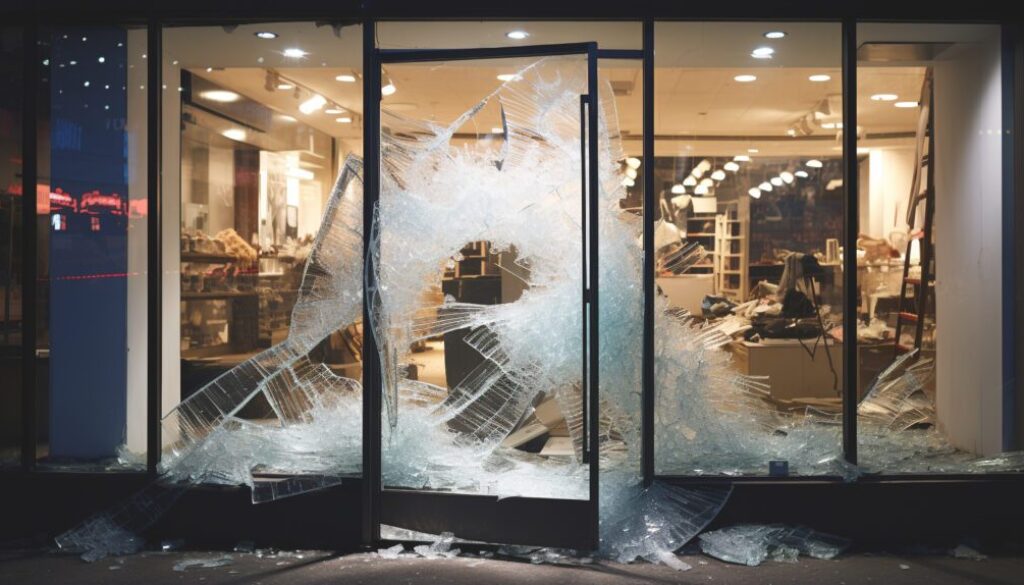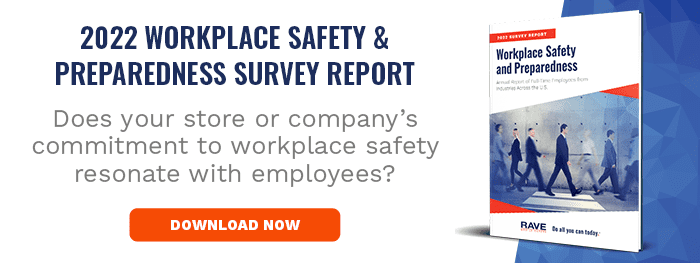From Awareness to Action: Employee Safety in the Face of Organized Retail Crime
Key Takeaways
- Unlike low-level shoplifting, organized retail crime is characterized by meticulous planning, deliberate targeting of retailers, and sophisticated coordination.
- A 2023 National Retail Federation survey found that 67% of respondents reported an increase in violence associated with organized retail crime
- Pairing safety technology like Rave AppArmor or Rave Mobile Panic Button app with ongoing safety training can help minimize the vulnerability of employees.
Retailers are increasingly concerned about employee safety considering the rising number of organized retail theft crimes. This not only leads to the loss of valuable merchandise but also disrupts store operations and compromises the security of personnel. A recent National Retail Federation (NRF) survey found that retail crime accounted for $112.1 billion in losses in 2022. The bulk of the amount can be attributed to organized retail crime.
What is Organized Retail Crime?
Unlike individual shoplifting thefts, organized retail crime (ORC) involves multiple thieves swarming stores for products they can resell online. Law enforcement experts say the individuals act as a gang and brazenly walk into a store collecting items that can be then resold either on online marketplaces or on peer-to-peer shopping websites.
In contrast to random theft or low-level shoplifting, organized retail crime is characterized by meticulous planning, the deliberate targeting of retailers, and sophisticated coordination. Shoplifting crimes are viewed as opportunistic also known as a “theft of need” due to economics. Retail executives view the methods of retail crime gangs as a “theft of greed.”
Retail crime experts say organized retail thefts are methodical in their approach to unsuspecting businesses as these “individuals steal frequently, often moving across county and state lines.” These syndicates are systematic in which retailer(s) they target and which merchandise to steal.
Another key differentiator of organized retail crime actors from a small group of thieves working in consort? These individuals have specific fencing operations to sell their stolen merchandise and may often be part of multi-national criminal enterprises.
More Violent Retail Crime Acts
In the 2023 survey, 67% of respondents reported more violence associated with organized retail crime than a year ago. Recent cases include:
- Nashville: the suspects sprayed a security guard with bear spray. Several bystanders were exposed to the fumes, prompting EMS units to come to the mall. Mall managers say thankfully nobody was seriously injured or transported.
- San Francisco: Police arrested six people in connection with an organized retail theft ring. The suspects entered a business wearing masks and quickly filled their bags and a wagon with store merchandise. At one store, police say one of the thieves warned an employee that intervening
- New York City: Four masked men marched in a line through a big-box store one afternoon. Surveillance video caught two of the men pushing carts stacked with product out of the store.
Unfortunately, this scenario has become all too prevalent in stores of all sizes. Small, independent retailers are particularly vulnerable due to their limited resources and late operating hours. Unlike national chain stores, “mom ‘n’ pop” shops are less likely to have robust insurance coverage, making business resiliency a greater challenge.
Keeping Employees Safe Storewide
Many retailers tell employees not to intervene in suspected cases of shoplifting, as the companies have asset-protection associates trained to confront shoplifters. In some cases, intervening during a crime in progress goes against company policy. Some store managers believe the risk of harm to the employee or surrounding customers is too great a risk to take over replaceable products.
While employers assert their duty of care encourages, and often demands employees not engage with a crime in progress – using mobile panic button solutions become a reliable call for help, but a crime fighting tool.
Found mostly in higher-end retailers, relying on a physical panic button is cumbersome and may be cost prohibitive for smaller businesses and office settings.
Physical panic buttons are typically located behind the register or along the counter. The familiar location makes them easy to locate for cashiers, but floor and frontline employees may be left without a way to call for help or alert law enforcement.
Mobile panic buttons are more reachable to all staff, as store employees have peace of mind with a call for help right in their pocket all the time and just a screen tap away.
In the case of emergencies mobile panic buttons found in safety apps like Rave AppArmor allow a staff member to call for help discreetly with a push the panic button icon. The mobile panic button would automatically send the location and a notification to security.
The store’s Security team can then decide to escalate the emergency and trigger a mass notification to all staff members (or specific groups of) in a manner of seconds using Rave Alert.
The notification can then be pushed via multiple communication channels such as through their custom AppArmor app, SMS, email, a desktop-notification and more.
Warehouse or behind-the scene team members may not hear or know about the danger occurring at the front of the store. Safety and protection mobile apps Rave AppArmor can warn employees of the brazen theft while the crime is underway, so they may call for help, shelter-in-place or safely escape.
Mobile panic buttons are more reachable to all staff, as store employees have peace of mind with a call for help right in their pocket all time and just a screen tap away. Rave AppArmor can also include store or company safety and security information and notifications such as:
- The latest neighborhood business crime alerts and personal warnings
- Company or store security measures & handbook
- Safety guides and protocols such as an active shooter or other acts of violence in the workplace
- Store operational procedures and contact information, and
- Shift activity forms and reports
With features such as texting, employees create a reliable, internal communication space for sharing shift handoff information within their team through chat rooms.
The community building features in Rave AppArmor are especially useful for your store closing team and lone workers who may work away from the storefront or are isolated, deep in the warehouse or showroom floor. With the ease of AppArmor’s content management dashboard – managers can easily add a check-in icon. In large retail big box or department stores with staff distributed all over, a floor manager or team leader creates a touchpoint for dialogue on shift-related or safety issues.
Minimizing Employee and Customer Vulnerability
To overcome the ongoing threat of organized retail crime, pairing safety technology and ongoing safety training can keep employees and customers safe, and businesses holding steadfast in their Duty of Care responsibilities:
- Schedule routine crime inspections by local police. Many local police departments offer inspections to mitigate vulnerabilities of stores and their employees.
- Encourage police officers to visit frequently.
- Ongoing training on workplace violence will help employees to be vigilant for potential threats.
While no profit or showroom product is more important than the lives of employees and customers, the effects of bold criminals are felt long after the actors leave the scene of the crime or are caught by law enforcement.
Retailers are cutting store hours and increasing security in response. Many businesses are closing key locations, leading to unemployment or reassignment of employees, and lack of shopping options for communities they serve.





